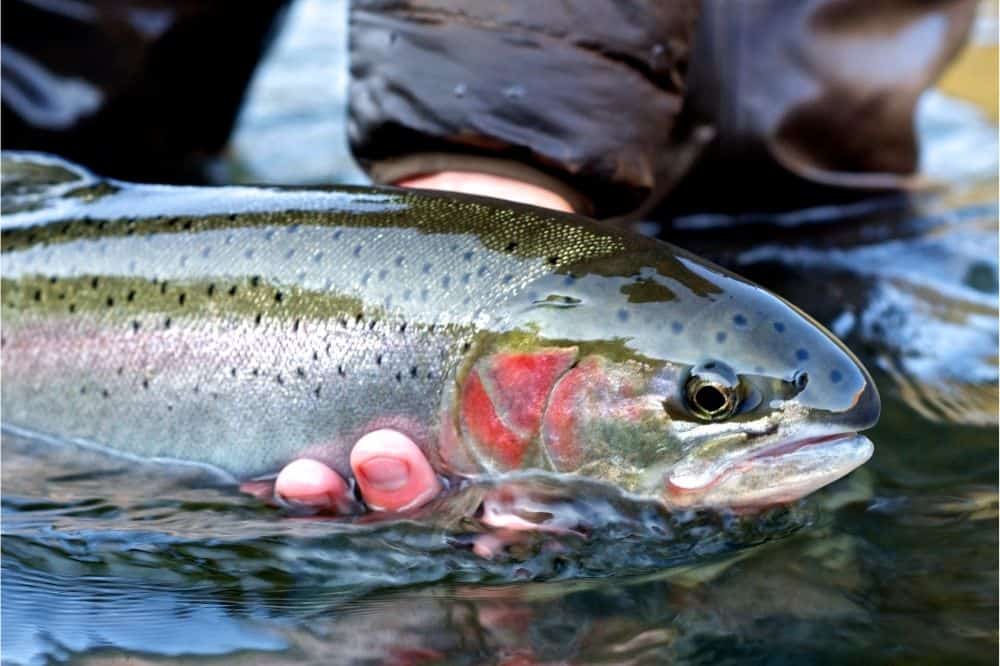Steelheaders in the Pacific Northwest often cite the 90/10 Rule, in which 10 percent of the anglers catch 90 percent of the fish.
While the 90/10 Rule more than holds water across most of Washington, where only about one in 20 anglers tags a steelhead each year, the Evergreen State’s two smallest counties busted that rule to bits.
Steelhead are definitely not easy to catch, especially these days, so you might want to know where anglers seem to have a better chance at beating the odds.
For the 2021-22 year, the latest for which statistics are available, the most successful steelheaders lived in southeastern Washington’s tiny Garfield County, home to a smidge over 2,300 people.
Anglers in this county managed to tag an average of 0.38 steelhead per catch record card during that 12-month span, according to the Washington Department of Fish and Wildlife’s Washington State Sport Catch Report 2021.
Washington’s next smallest county, Wahkiakum County along the lower Columbia River, landed in second place by averaging 0.26 steelhead per catch card.
Those counties flipped the top two spots from the previous year, when it was Wahkiakum County steelhead anglers who averaged 0.38 keepers per tag. Garfield County anglers tagged an average of 0.29 that year.
Compare that to the statewide statistics: All Washington anglers averaged just 0.04 steelhead per catch card in the same period. That was down from 0.06 the previous year.
Steelhead aren’t called the “Fish of 1,000 Casts” for nothing; usually it takes more casts than that to catch one.
Wahkiakum County is between Cowlitz and Pacific counties and has Washington’s second-smallest population with a little over 4,500 people, many of whom live in and around Cathlamet.
This county also wins the distinction of having the highest number of residents take part in fisheries that require the catch cards. Nearly a quarter of all residents of Cathlamet and other Wahkiakum County areas were eligible to fish for steelhead in 2021-22, up a little bit from the previous year.
It’s also worth noting that steelhead are far more elusive than the primary salmon species that anglers also mark on their catch cards. In many cases, salmon rather than steelhead are the main reason anglers obtained a catch card in the first place.
The statewide average for salmon harvests was 1.12 per catch card in the 2021-22 season when anglers tagged 675,128 salmon. That same year, anglers tagged just 21,867 steelhead. Those statistics don’t include released fish, which includes wild steelhead.
Speaking of the more challenging steelhead, there are a couple of good reasons why the anglers in these two counties fare so well when it comes to tagging hatchery-reared ironhead.
Location, Location, Location
It makes perfect sense: These two counties are close to good runs of hatchery-marked steelhead, the only ones Washington anglers can take home to eat.
Garfield County’s backyard fishery is the lower Snake River, which punched out more than 4,200 steelhead in 2021-22. The Grande Ronde River and likely some other fisheries also contributed to the catches as well.
Wahkiakum County not only has the Columbia River and its summer-run fishing in its front yard but is also home to the Elochoman River’s moderate runs of both summer and winter steelies. It’s also not far from Pacific County’s tributaries around Willapa Bay and Cowlitz County’s fisheries, including the famous Cowlitz River.
Just a handful of other counties in Washington also managed to average more than 0.10 steelhead tagged per angler during 2021-22. They were Lewis County (0.17) and Cowlitz County (0.12), home to the Cowlitz River’s big hatchery steelhead runs and several Lower Columbia fisheries, and Asotin County (0.10) near the Snake and Grande Ronde rivers in the far southeastern corner of the state.
Other standout counties in the previous year included Grays Harbor on the coast and Whitman in southeastern Washington.
Math
Admittedly, when you’re looking at many of these smaller, more rural locations, you’re not only counting a population more geared to angling than the big cities, you’re looking at small numbers, period. Less obvious changes in angler participation and the up-and-down nature of steelhead runs play a big role in the calculations.
For example, Asotin County anglers managed to land 521 steelhead in 2020-21 but tagged just 206 the following year. At the same time, total catches went up for anglers in neighboring Garfield County.
By contrast, Washington’s most heavily populated counties often charted the least-impressive results. While King County (Seattle/Bellevue) residents tagged a state-leading 3,379 steelhead for the most recent statistical period, that’s just over 3 percent of its nearly 98,000 eligible anglers.
Other urban areas like Pierce (Tacoma), Snohomish (Everett), Spokane and Clark (Vancouver) counties also saw no better than five harvests per 100 catch cards.
Most of the counties sitting east of the Cascades and far north of the Snake River also had lower-than-average catches. We can safely say that long travel times to productive steelhead water played a role there, and as elsewhere in the state, many of those anglers were likely targeting salmon.
Catch More Steelhead
These are the best steelhead fishing rivers in Washington.
And these are some of the popular ways to catch them.
Washington Resources
WDFW Fishing and Stocking Reports
WDFW Fishing Regulations
National Weather Service forecasts

